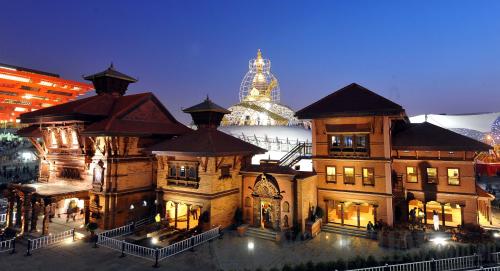|
 |
|
PAVILION BY NIGHT: The Nepal Pavilion presents the country's traditional architecture to visitors at the 2010 World Expo in Shanghai (LUO XIAOGUANG) |
The ongoing 2010 World Expo in Shanghai has attracted the whole world's attention with its creative pavilions and displays of distinctive cultures. Tanka Prasad Karki, Ambassador of Nepal to China, talked to Beijing Review reporter Yu Yan about his country's pavilion, its tourism campaign and bilateral exchanges between China and Nepal.
Beijing Review: Could you please tell us about the Nepal Pavilion at the World Expo?
Tanka Prasad Karki: The Nepalese people are proudly showcasing their traditional architecture at the Shanghai World Expo 2010. The theme of the Nepal Pavilion at the Expo is "Tales of Kathmandu City." The architecture represents the city and its unique designs of houses and temples. Temples of different religious sects exist side by side in Kathmandu, showcasing our harmonious society.
The architectural design of the Nepal Pavilion centers on a temple depicting the philosophies of Hinduism and Buddhism, and it combines traditional arts and modern structure. The entire area is themed around Swayambhunath Stupa, the oldest holy shrine in Kathmandu. The pavilion thus may well be revered as Manjupatan, the oldest settlement in Kathmandu. We have witnessed an influx of visitors during the initial days of the Expo, and believe our pavilion will continue to attract a greater number of visitors in the coming days. The "Tales of Kathmandu City" is also in harmony with the main theme of the Expo—"Better City, Better Life."
If you are visiting the Expo, I hope that you could also spare some of your time to visit the Nepal Pavilion. Our pavilion with its lofty appearance stands just beside the China Pavilion. So, it is conveniently located and easy for taking a tour. You will have a magnificent view from the closest overhead passage. It is one of the best places to take a photo of the Nepal Pavilion, with the eye-catching China Pavilion in the background.
Our stalls also sell attractive handicraft collections from Nepal, which visitors can buy as souvenirs. Stalls selling food with Nepalese flavors are also attracting numerous visitors.
I would like to tell you September 3 is Nepal Day at the Expo, and we are working on the visit of our president, the Right Honorable Ram Baran Yadav, to China for that occasion.
What's your impression of the Expo?
I joined the diplomatic envoys in Beijing in attending the grand and spectacular opening ceremony of the Expo. In my short stay in Shanghai, I also had the opportunity to visit China's and some other countries' pavilions. The Chinese exhibition hall houses a range of specialties of its diverse provinces, municipalities, autonomous regions and special administrative regions. South Asian countries' pavilions focus on the region's ancient aspects and arts as well as contemporary life. The Africa Joint Pavilion also successfully showcases their unique features, while European countries have brought out excellence in innovative technologies. I liked seeing all these pavilions, and believe every country or institution is successfully bringing out their talent and caliber.
You have been working in China for more than two years. Which Chinese cities have you been to? Which city do you like best?
Yes, it is about two and a half years since my arrival in Beijing. During this time, I have traveled to several places in China and have had opportunities to educate myself about the richness of its culture and society.
By asking about my most favorite city in China, you have really put me in a dilemma. I am deeply impressed by the progress China has achieved in every aspect, especially after the reform and opening-up policy of the late 1970s. The beauty of each place is uniquely superb. Among the places I visited, Wutai Mountain (in Shanxi Province), Jiuzhaigou (Sichuan Province), Xiamen (Fujian Province), Guilin (Guangxi Zhuang Autonomous Region) and Dali (Yunnan Province) are blessed with unmatched scenery. But I am not doing an injustice to the marvels of other places by not mentioning their names. Xi'an (Shaanxi Province), which is Kathmandu's sister city, holds historical and cultural legacies of ancient China. No one may fail to notice Chongqing's economic prowess and Shanghai's vibrancy as one of the world's important economic and commercial hubs. Beijing is a big, beautiful and simple, yet mysterious capital city. I am really enjoying my life here.
This year marks the 55th anniversary of the establishment of diplomatic relations between China and Nepal. How do you view the bilateral exchanges and cooperation between the two countries?
It is indeed a pleasure to celebrate the 55th year of establishment of diplomatic relations. The history of our cultural, social and economic relations with China goes back centuries, even though the diplomatic relations were only established in 1955. Historical records show Nepal and China have had official links through the exchanges of envoys since the 7th century. Chronicles have recorded evidence of the excellent relations, trust and cooperation between Nepal and China for centuries.
|